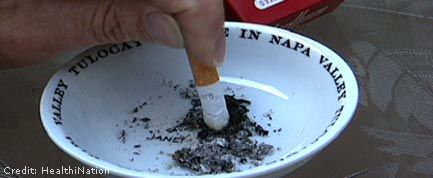The Dangers of Third-Hand Smoke Revealed

Add a new health threat to smoking: In addition to the harm caused by actually smoking and exposure to second-hand smoke, so-called third-hand smoke may also pose a threat, particularly to babies and toddlers.
A new study reveals that the residue of nicotine that lingers on surfaces can react with another chemical in the air to form potent carcinogens — chemicals linked to various cancers. While first-hand smoke is that inhaled directly by the smoker and second-hand is the smoke exhaled (and inhaled by others), third-hand smoke is the residue from second-hand smoke.
Anyone who has entered a confined space — a room, an elevator, a vehicle, etc. — where someone has recently been smoking, knows that the scent lingers for an extended period of time.
"The burning of tobacco releases nicotine in the form of a vapor that adsorbs strongly onto indoor surfaces, such as walls, floors, carpeting, drapes and furniture. Nicotine can persist on those materials for days, weeks and even months," said Hugo Destaillats, a chemist with Lawrence Berkeley National Laboratory in San Francisco, and one of the authors of the study.
Scientists have been aware for several years that tobacco smoke sort of sticks to surfaces where it can react with other chemicals. But reactions of residual smoke constituents with molecules in the air have been overlooked as a source of harmful pollutants, the researchers of the new study say.
Destaillats and colleagues investigated the formation of harmful chemicals in the air after exposing material to cigarette smoke. They found that it reacts with one chemical in particular.
"Our study shows that when this residual nicotine reacts with ambient nitrous acid it forms carcinogenic tobacco-specific nitrosamines or TSNAs," Destaillats said. "TSNAs are among the most broadly acting and potent carcinogens present in unburned tobacco and tobacco smoke."
Sign up for the Live Science daily newsletter now
Get the world’s most fascinating discoveries delivered straight to your inbox.
Unvented gas appliances are the main source of nitrous acid indoors.
The researchers used cellulose as a model of indoor material, and exposed it to cigarette smoke. They then exposed it to a "high but reasonable" concentration of nitrous acid for three hours. The levels of newly formed TSNAs were 10 times higher after the nitrous acid exposure. The TSNAs also formed quickly, the researchers found.
"Given the rapid sorption and persistence of high levels of nicotine on indoor surfaces, including clothing and human skin, our findings indicate that third-hand smoke represents an unappreciated health hazard through dermal exposure, dust inhalation and ingestion," said lead author Mohamad Sleiman, also of Berkeley Lab.
Since most vehicle engines emit some nitrous acid that can infiltrate the passenger compartments, tests were also conducted on surfaces inside the truck of a heavy smoker, including the surface of a stainless steel glove compartment. These measurements also showed substantial levels of TSNAs.
Individuals are most likely exposed to these TSNAs through either inhalation of dust or the contact of skin with carpet or clothes, suggesting third-hand smoke might pose the greatest hazard to infants and toddlers.
And the study's findings, detailed in the Feb. 8 issue of the journal Proceedings of the National Academy of Sciences, indicate that opening a window or deploying a fan to ventilate the room while a cigarette burns does not eliminate the hazard of third-hand smoke.
Smoking outdoors is not much of an improvement.
"Smoking outside is better than smoking indoors but nicotine residues will stick to a smoker's skin and clothing," said study co-author Lara Gundel, also of Berkeley Lab. "Those residues follow a smoker back inside and get spread everywhere."
"What we see in this study is that the reactions of residual nicotine with nitrous acid at surface interfaces are a potential cancer hazard, and these results may be just the tip of the iceberg," said Kamlesh Asotra of the University of California's Tobacco-Related Disease Research Program, which funded this study.
In their paper, the authors suggest several ways to limit the impact of third-hand smoke, including the implementation of 100 percent smoke-free environments in public places and self-restrictions in residences and automobiles. In building where high levels of smoking has occurred, replacing furnishings, carpets and wallboard could reduce exposures.
- Video: Anti-smoking Ads That Work
- Never Too Late: 5 Bad Habits You Should Still Quit
- Smoking's Many Myths Examined












